d e s i g n 22 s p e c i f i c a t i o n s
p a r t s1so fs 3
|
• part two of three • part three of three • |
| This document is for the UniCredit Academy design/build/use Team. It incorporates my notes which will be added and updated as the design and implementation of the project unfolds. Because it is updated periodically, this URL should be checked often. This is a private site and requires a password to enter. It is linked extensively to public documents on my, site as well as, to resources on other sites which are open. The idea is that philosophy-to-task can be captured and documented. Contrary to most architects I do not attempt to dominate the design process. I will get involved in both large to small design decisions and will challenge every detail - however, this is not a pride of authorship thing. The goal is to produce the best possible result - not to win theoretical design arguments. I invite collaboration and see what I do as “creating a problem” [link: creating the problem model ] for the many disciplines that are involved in executing a project of this complexity. I do not believe in compromise - I expect that we will, together, always be able to find the best solution that resolves the many often conflicting design objectives inherent in any project. If other members of the design team create similar electronic documentation, wiki or blog sites, it will be good practice to link these together, in detail, as is appropriate. |
|
|
taylor_design_build_process |
A message from Matt Tatyor about the Design-Build process of MG Taylor:
Unicredit is building an unique, world class learning and design center. In MG Taylor’s terms we call these NavCenters [link:] - “Nav” for navigation because they are designed and equipped with tools and processes to facilitate an organization’s ability to navigate an uncertain future. They do this by augmenting human intelligence and by facilitating the emergence of GroupGenius® [link:]. MG Taylor has build many NavCenters for partners and clients employing patterns derived from its U.S. Patent [link:]. Each one is different in order to address the real circumstances and challenges of a specific time, place and application. The pattern language is consistent - each design is a response to an unique set of conditions. To accomplish this requires the collaboration of a variety of experts from the client environment, their consultants, architects, designers and builders, as well as the internal MG Taylor organization and external ValueWeb® [link:]. |
| To be successful, the design process has to be iterative and go through what we call the 4 Step Process [link:] and Design Formation [link:] Models. These will be introduced below. In order for a design to be both integrated and the result of a collaborative process, the preliminary concept has to be developed in such a way that a PROBLEM [link:] is created which creates a framework within which each specific discipline can be free to develop while achieving, in the end, an integrated, economical solution. The lead design role of such a process is what we call a System Integrator and I have undertaken this responsibility. Thus, Unicredit Real Estate and Permasteelisa remain in their fiduciary and contractual roles are thereby able to perform as they usually do. It also allows the the special experience which MG Taylor has accumulated in 25 years of building collaborative environments [link:] to find its way into the overall design-build process of the project without interfering with these contractual relationships and the normal procedures of the individual organizations which are involved. We call this the NASA process [link: how nasa went to the moon] as it is derived from our analysis of how they really functioned in the glory days of the Moon Program. This process is also derived from over 45 years of design-build experience [link:] on my part. |
| While the design development, engineering, manufacturing and construction of the physical space is underway, MG Taylor and Architectz [link:], our Italian partner, will be working with Unicredit to prepare for the use of this environment. A portable (RDS [link:]) environment is being set up to facilitate this experience. |
| The purpose of this document: Design Specifications is to establish, in concrete terms, the performance requirements of the overall Unicredit Academy environment - as a system - including the details of its major subsystems. This sets the design boundaries of the many disciplines which are required to produce the final result. It creates a problem-to-be-solved for each of these disciplines and establishes a context in which the work can be done. This document ranges, therefore, from the philosophy of the work to specific design objectives. This document has to be understood in concert with the Unicredit Preliminary Design [link:] and Program Statement [link:] documents which are linked to this document. The philosophy of the UNiCredit NavCenter is as important as the design objectives and specifications. I consider architecture to be built philosophy [link:] and NavCenters to be engines of creativity and innovation. We are building a thing. What determines how it must be built is a no-thing - a philosophy and practice of creative work. If the philosophy is understood, creativity is released. If it is not, the whole is sacrificed to a bundle of components that, no matter how well done, will not lead to the gestalt required. In this circumstance, the only remaining response is for the system integrator to attempt to impose specific solutions. Not only is this impossible it leads to an inferior result. |
| A word about time. This project has a short period to get to opening. Its inherent complexity calls for a lengthily design period which we do not have. This means we have to fast-track the design-build process. To do this successfully, a great deal of trust, transparency and high level teamwork is required. Any mistake is the whole team’s failure and the success of the project will be the whole team’s achievement. It will do no good for one part of us to have done well while another part experiences a failure. We are not working for each other or even the client other than in the legal sense. We are working for the project and what it enables Unicredit to achieve in the future. This is how the value is reached not in the thing which we build. |
|
m a p p i n g a t h e a s y s t e m |
| The SYSTEM of the Unicredit Academy NavCenter is composed of functional process components each described in a matrix of three dimensions: one dimension is the thing - what we are going to build; the second, the function - what it has to do; and the third, performance how we know it is doing what it must. The components are organized by the 7 Domains Model which outlines the environment necessary for and supportive of systematic knowledge formation, creative and collaborative work processes, learning, a flexible and healthy physical work environment, technology augmentation, project management and a venture management process capable of systematic and sustainable innovation. |
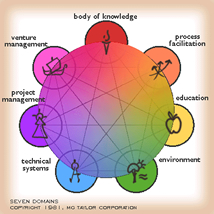 |
The 7 DOMAINS MODEL is a basic audit tool of the Taylor Method. Click on the diagram (left) to go to an Audit of the next generation Taylor environment and system.
link: basic description of the 7 Domains Model |
|
| Familiarity of the 7 Domains Model and the next generation Taylor Environment and System - as a system - is essential for an in depth understanding of the Unicredit Academy NavCenter description which follows. Every owner of a Taylor “NavCenter” calls their facility by a different name. I use the phrase “UniCredit Academy NavCenter,” here, not to suggest that it should be called this but to distinguish this part of the Academy, which MG Taylor is primarily involved in, from the far larger other facilities which are also being developed. |
functional_process_components |
| The Functional Process COMPONENTS of the UniManagement NavCenter are: |
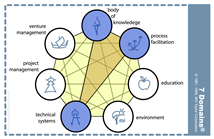
|
| Knowledge creation, capture, storage, retrieval and employment, as an integrated way of working throughout the UniCredit enterprise |
|
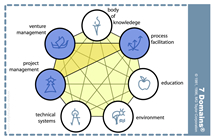
|
| Teaching, facilitating and putting to strategic and daily practice, collaborative design skills promoting a culture of GroupGenius.® |
|
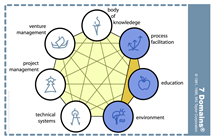
|
| Being a knowledge intensive, networked physical/virtual work environment making Unicredit human capital requisite with future change and complexity |
|
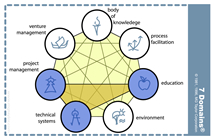
|
| Transferring the skills of knowledge-work, networking, weak signal research, project management, strategic thinking as a distributed, pragmatic work habit |
|
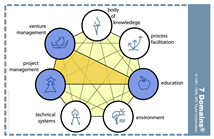
|
| Inventing and sustaining the concept of the venture and integrating each individual’s learning program directly to their present and future work |
|
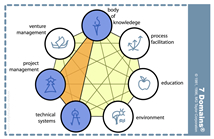
|
| Tracking, distributing and re-using key knowledge and insuring knowledge succession through projects which build necessary corporate cognitive capacity |
|
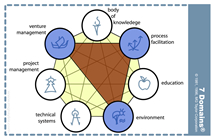
|
| As a physical metaphor of Unicredit, employ simulations, multimedia, design experiences and embed this image in the memory of Unicredit and its entire ValueWeb |
|
| All 7 Domains are necessary in support of each of these Components. The ones highlighted in triads are the primary ones most critical for each Component outlined. |
| The UniCredit Academy NavCenter will support many programs and functions, involving both conventional and new types of work-learning processes. These seven Functional Process Components are the key consequence of the UniCredit Program Statement requirements and express the primary reason-to-be of the NavCenter portion of the total environment. Click on each of the diagrams to see their derivation in the Program Statement. |
|
|
| Return to INDEX Unicredit Academy |
|
|
|
|
| Return to INDEX Matt Taylor Biography |
|
|
|
|
| GoTo: UniCredit NavCenter INDEX |
|
|
|
|
| Link: Project Phasing Options |
|
|
|
|
| GoTo: ver 2.5 Line Drawings INDEX |
|
|
|
Matt
Taylor
Milan
February 14, 2006
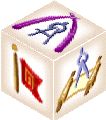
SolutionBox
voice of this document:
ENGINEERING • STRATEGY • PRELIMINARY
|
|
posted:
February 14, 2006
revised:
March 24, 2006
• 20060214.421988.mt • 20060214.341908.mt •
• 20060216.333300.mt • 20060202.546300.mt •
• 20060324.410091.mt •
Copyright© 1987, 2006 Matt Taylor
(note:
this document is about 60% finished)
|
|
|